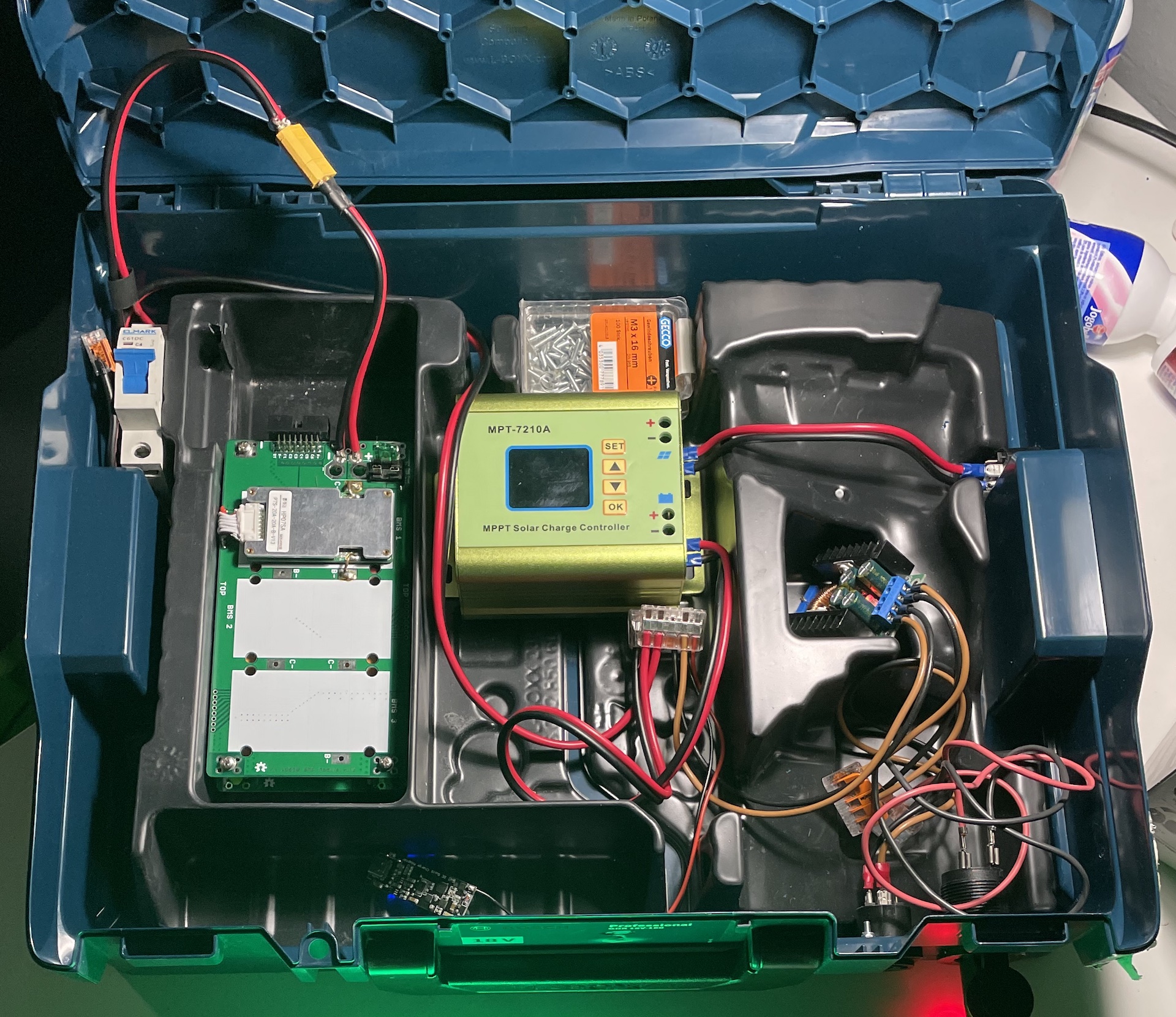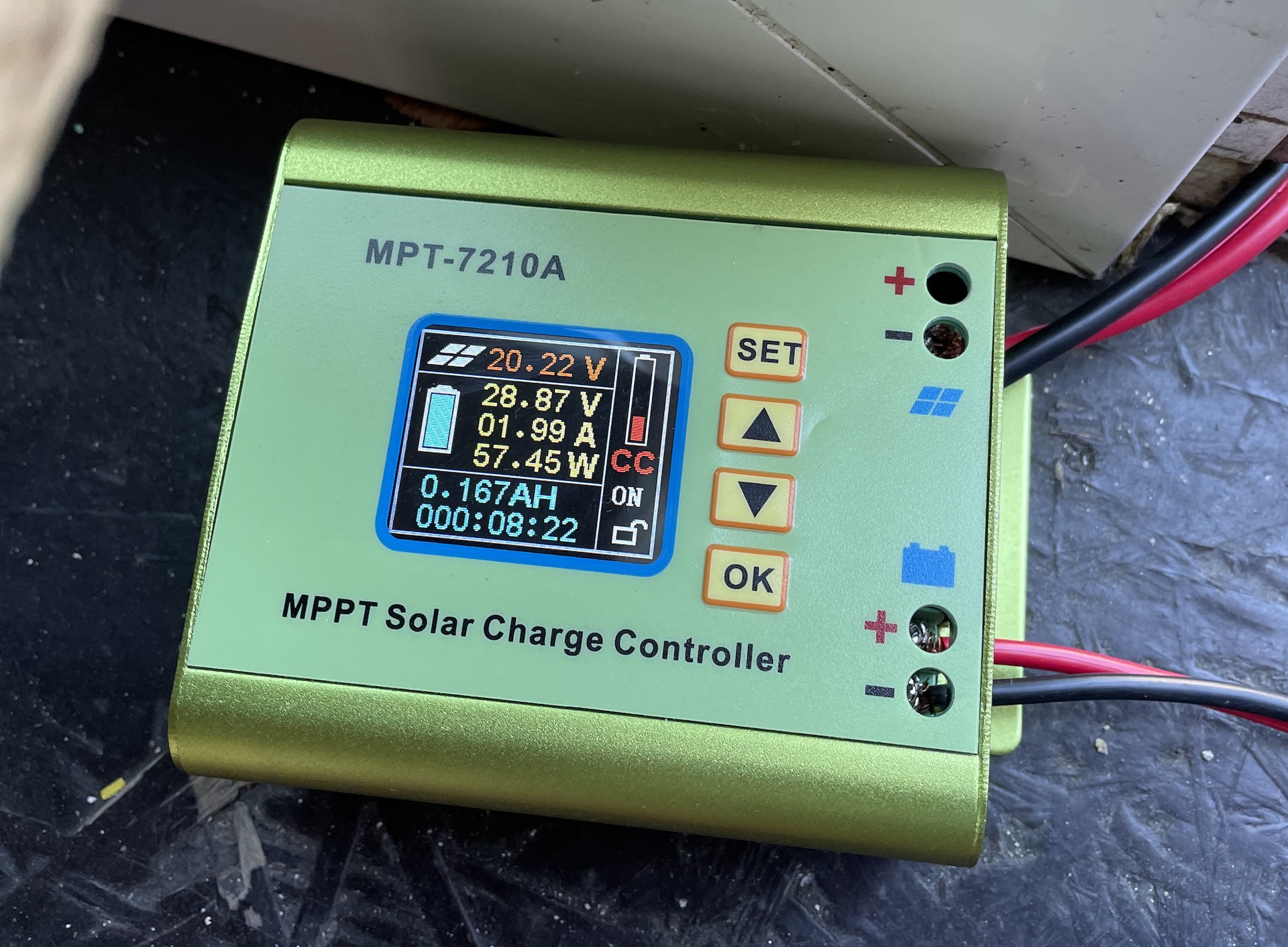DIY Power Station

A small power station / solar generator, in a L-BOXX suitcase, with the following components
- Battery: 7S Lithium-Ion, using recycled 18650 batteries, ~24V system voltage
- Solar Charge Controller: MPPT Step-Up Charger, 10A
- Step Down Converter for 12V outputs
- USB-PD board with USB-A and USB-C connectors
Overview
┌─────────────────────────────────────────────────────────────────────────────┐ │ │ │ ┌──────────┐ ┌─────────────┐ ┌───────────┐ ┌───────────┤ │ │Battery + ├───────┤DC Circuit │ │Solar ├───────────┤Solar Input│ │ │ BMS │ │ Breaker 4A │ │ Charger │ │ (Speakon) │ │ │ │ └───────┬─────┘ │ │ └───────────┤ │ │ 24V │ │ │ │ │ │ └──────────┘ │ │ │ │ │ │ │ │ │ │ │ │ │ │ │ │ └──┬────────┘ │ │ │ │ │ │ ┌──┴─────────────┴────┐ │ │ │24V Distribution │ │ │ │ via Wago connectors│ │ │ └─┬────────────────┬──┘ │ │ │ │ │ │ ┌────────────┴────┐ ┌──┴────────────┐ │ │ │USB PD controller│ │24->12V │ │ │ └─────────────────┘ │ DCDC converter│ │ │ └─┬─────────────┘ │ │ │ │ │ ┌─┴───────────────────┐ │ │ │12V Distribution │ │ │ │ via Wago connectors│ │ │ └─┬───────────────┬───┘ │ │ │ │ │ │ ┌─┴──────┐ ┌───┴───────────────┤ │ │Speakon │ │"Cigarette lighter"│ │ │ │ │ connector │ └───────────────────────────────────────────┴────────┴────┴───────────────────┘
Battery
The battery is made up of recycled 18650 cells. They are not spot-welded or soldered into a battery pack, but instead placed in proper battery mounts on a set of PCBs, currently one for battery mounts, and one containing a BMS. I got them readily assembled via AliExpress, the original design seems to be from Jehu Garcia:
- Battery board - I’m using the “High Power” version
- PCB in Jehu’s shop
- Populated Hight Power module in Jehu’s shop
- AliExpress version - I have the “7S 2P advanced” variant
- Replacement parts: I tripped the fuse on one of the boards:
- AliExpress
- Reichelt: 1, 2
- BMS Board
- Jehu’s shop only links the the gerber files for the BMS PCB version I’m using here: Gerber Files in Shop
- AliExpress version - the “7S 20A BMS” matches the current configuration
The first few videos in this YT playlist are about this kind of battery: DIY Powerwall PCB system
The battery is connected with XT60 connectors via an additional DC circuit breaker, which mostly serves as a master switch.
Capacity
7S2P configuation at the moment, with ~2200mAh per battery cell.
2.2Ah * 14 (no of batteries) * 3.7V = 113,96 Wh ~= 0,1 kWh
The plan is to add a second layer of cells, doubling the capacity.
Charge Controller
 I wanted to be able to charge the power station from smaller solar panels, which would likely provide a lower output voltage than the system voltage of the battery. So it was necessary to use a solar charger that would accomodate that.
I wanted to be able to charge the power station from smaller solar panels, which would likely provide a lower output voltage than the system voltage of the battery. So it was necessary to use a solar charger that would accomodate that.
The “MPT-7210A” charge controller, available from a number of sellers on AliExpress (just one example), mentions a configurable output voltage of 15-90V with input voltages of 12-60V. This seemed to match my requirements.
Some notes from using the charge controller:
- Compared to most cheap-ish Chinese charge controllers, this one does not have any functions to switch a load.
- The connectors are best used with M4 cable shoes. Connecting wires directly to the terminals is almost impossible.
- With low input power, the controller seems to go down to 0W frequently.
Open Points
- More fuses, ideally one for each consumer
- Switches to be able to turn off consumers individually
- Something combinded with the fuses into some sort of fancy distribution board?
- e.g. PowerPole 6-bank Distribution Board
- Voltage display
- Data accquisition
References / Other designs
- AG KRITIS
- Infinity Solar Bank - Project using supercapacitors for energy storage
- Footprint Project
- “MegaPack” a 12V 5200mAh Battery Pack
- LibreSolar OSHW BMS
- Hackspace Magazine 52 - How I made a portable solar generator (p. 44ff)